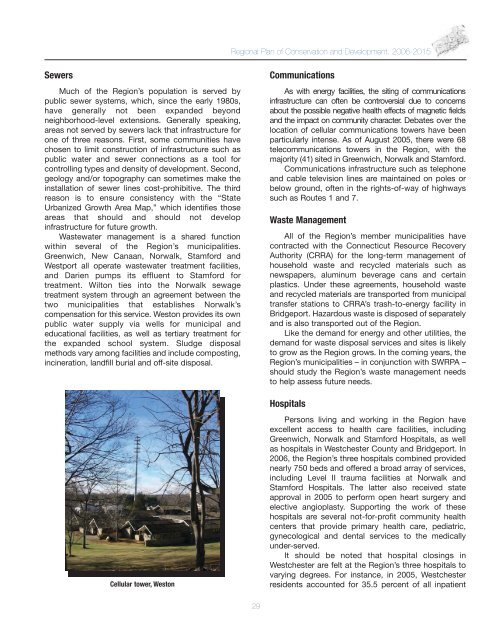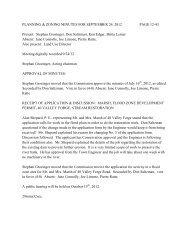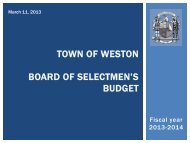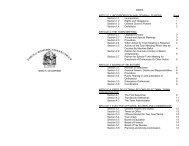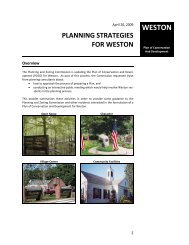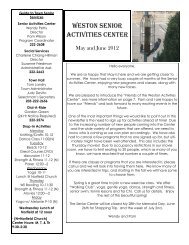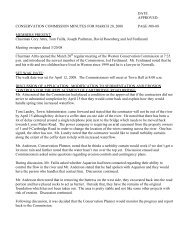Regional Plan of Conservation and Development, 2006-2015
Regional Plan of Conservation and Development, 2006-2015
Regional Plan of Conservation and Development, 2006-2015
You also want an ePaper? Increase the reach of your titles
YUMPU automatically turns print PDFs into web optimized ePapers that Google loves.
<strong>Regional</strong> <strong>Plan</strong> <strong>of</strong> <strong>Conservation</strong> <strong>and</strong> <strong>Development</strong>, <strong>2006</strong>-<strong>2015</strong>SewersMuch <strong>of</strong> the Region’s population is served bypublic sewer systems, which, since the early 1980s,have generally not been exp<strong>and</strong>ed beyondneighborhood-level extensions. Generally speaking,areas not served by sewers lack that infrastructure forone <strong>of</strong> three reasons. First, some communities havechosen to limit construction <strong>of</strong> infrastructure such aspublic water <strong>and</strong> sewer connections as a tool forcontrolling types <strong>and</strong> density <strong>of</strong> development. Second,geology <strong>and</strong>/or topography can sometimes make theinstallation <strong>of</strong> sewer lines cost-prohibitive. The thirdreason is to ensure consistency with the “StateUrbanized Growth Area Map,” which identifies thoseareas that should <strong>and</strong> should not developinfrastructure for future growth.Wastewater management is a shared functionwithin several <strong>of</strong> the Region’s municipalities.Greenwich, New Canaan, Norwalk, Stamford <strong>and</strong>Westport all operate wastewater treatment facilities,<strong>and</strong> Darien pumps its effluent to Stamford fortreatment. Wilton ties into the Norwalk sewagetreatment system through an agreement between thetwo municipalities that establishes Norwalk’scompensation for this service. Weston provides its ownpublic water supply via wells for municipal <strong>and</strong>educational facilities, as well as tertiary treatment forthe exp<strong>and</strong>ed school system. Sludge disposalmethods vary among facilities <strong>and</strong> include composting,incineration, l<strong>and</strong>fill burial <strong>and</strong> <strong>of</strong>f-site disposal.CommunicationsAs with energy facilities, the siting <strong>of</strong> communicationsinfrastructure can <strong>of</strong>ten be controversial due to concernsabout the possible negative health effects <strong>of</strong> magnetic fields<strong>and</strong> the impact on community character. Debates over thelocation <strong>of</strong> cellular communications towers have beenparticularly intense. As <strong>of</strong> August 2005, there were 68telecommunications towers in the Region, with themajority (41) sited in Greenwich, Norwalk <strong>and</strong> Stamford.Communications infrastructure such as telephone<strong>and</strong> cable television lines are maintained on poles orbelow ground, <strong>of</strong>ten in the rights-<strong>of</strong>-way <strong>of</strong> highwayssuch as Routes 1 <strong>and</strong> 7.Waste ManagementAll <strong>of</strong> the Region’s member municipalities havecontracted with the Connecticut Resource RecoveryAuthority (CRRA) for the long-term management <strong>of</strong>household waste <strong>and</strong> recycled materials such asnewspapers, aluminum beverage cans <strong>and</strong> certainplastics. Under these agreements, household waste<strong>and</strong> recycled materials are transported from municipaltransfer stations to CRRA’s trash-to-energy facility inBridgeport. Hazardous waste is disposed <strong>of</strong> separately<strong>and</strong> is also transported out <strong>of</strong> the Region.Like the dem<strong>and</strong> for energy <strong>and</strong> other utilities, thedem<strong>and</strong> for waste disposal services <strong>and</strong> sites is likelyto grow as the Region grows. In the coming years, theRegion’s municipalities – in conjunction with SWRPA –should study the Region’s waste management needsto help assess future needs.HospitalsCellular tower, WestonPersons living <strong>and</strong> working in the Region haveexcellent access to health care facilities, includingGreenwich, Norwalk <strong>and</strong> Stamford Hospitals, as wellas hospitals in Westchester County <strong>and</strong> Bridgeport. In<strong>2006</strong>, the Region’s three hospitals combined providednearly 750 beds <strong>and</strong> <strong>of</strong>fered a broad array <strong>of</strong> services,including Level II trauma facilities at Norwalk <strong>and</strong>Stamford Hospitals. The latter also received stateapproval in 2005 to perform open heart surgery <strong>and</strong>elective angioplasty. Supporting the work <strong>of</strong> thesehospitals are several not-for-pr<strong>of</strong>it community healthcenters that provide primary health care, pediatric,gynecological <strong>and</strong> dental services to the medicallyunder-served.It should be noted that hospital closings inWestchester are felt at the Region’s three hospitals tovarying degrees. For instance, in 2005, Westchesterresidents accounted for 35.5 percent <strong>of</strong> all inpatient29


